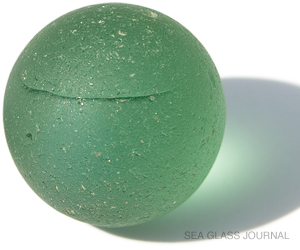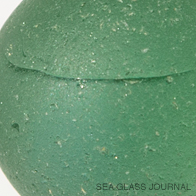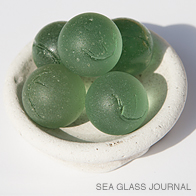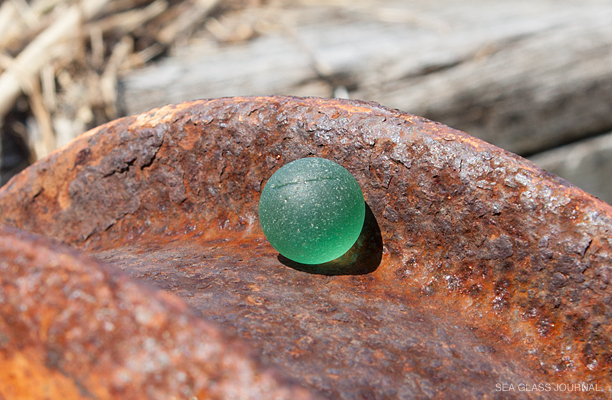The Sea Glass Shard of the Month: April 2016
Industrial Marble

See SLIDE SHOW
Sea Glass Specifications:
Color: Sea Green
Diameter: 19.1 mm (0.75")
Weight: 9.5 grams (0.33 oz)
Estimated Age: 80 to 100 years old
This month we will look at a type of sea glass marble, different from the more common toy marble, often found near railroad tracks and train station depots and chosen because its interesting if somewhat ambiguous history. If the station or tracks were located near a large body of water you also have the chance of finding them in sea glass condition as well, that is, having that desirable frosty patina and pitting.

This close-up reveals the fold lines found in this type of marble.

Various industrial marbles found in a harbor near an old boat building company. These marbles are not as conditioned as the featured specimen due to the limited surf conditions of the harbor.
Facts of Interest
In 1903, Martin Frederick Christensen of Akron, Ohio, made the first machine-made glass marbles on his patented machine. Before that, the first mass produced marbles in the US were made of clay.
Visual appeal and a clean surface were not the main concern in the making of this type of marble. They are most often found with a clear to greenish hue, lacking clarity and usually having one or two fold marks indicating a crude, inexpensive manufacturing process where a molten glob of glass was quickly folded and formed into a glass sphere.
 |
Because these marbles are commonly found along railroad tracks they are often referred to as railroad marbles. |
 |
Because these marbles are commonly found along railroad tracks they are often referred to as railroad marbles. A popular account is that they were used as roller bearings to assist in moving heavy freight in railroad depots as early as 1885. In an article first published in the Key, Lock & Lantern by Sam Ferrara in 1988, and republished on the website railroadiana.org, it is stated that these "marbles were purchased by the tons" for that purpose.
The problem with this account is that the first automated glass marble machine was not invented until the early 1900s. As pointed out in an article on the Ohio Metal Detecting website, prior to the automated process, glass marbles were made by hand and would have been extremely expensive to manufacture in such large quantities. If having roller bearings were a desired means of moving heavy freight, steel rolling bearings would have been a much less expensive option. Even with that, wheeled dollies were probably used for moving the freight.
The author of the Ohio Metal Detecting article also states that he found no outside sources to corroborate this account and goes on to suggest other more probable purposes for these marbles. One use was as cullet, or recycled glass, for the manufacturing of other glass products such as fiberglass, plate glass and automotive glass. In marble form, it was easier to maintain the addition of glass to a batch at a controlled rate[1].
Other suggested uses for these glass marbles were in hopper cars, whether to clean the insides where the contents could cake up or assist in the flow of the contents from the hoppers. The marbles could then be easily separated from the contents.
The author further advances that the marbles in question, similar to this month's featured marble, were in particular used in the production of fiberglass. The history of fiberglass production, which began in the 1930s, is beyond the scope of this article but it is easy to understand that the inexpensive manufacturing, transportation and controlled manner in which this type of glass marble could be utilized in making the glass fibers is a reasonable explanation for its existence.
These slightly imperfect glass marbles could have been used for any of the suggested purposes above, and more information about them may surface in the future. In any event the marbles were either shipped in by train or boat in large quantities to a depot or warehouse for the purpose intended. This is probably the reason why they are commonly found along or near railroad tracks and industrial complexes. This is also why, from this point on, the Journal will refer to them as industrial marbles rather than railroad marbles as the latter suggests a use that, more probable than not, is highly unlikely.
Happy sea glass hunting!
REFERENCES:
1. http://www.ohiometaldetecting.com/railroad-marbles.html

Keep up-to-date on all things sea glass... "Like Us" on Facebook... Sea Glass Journal on Facebook






